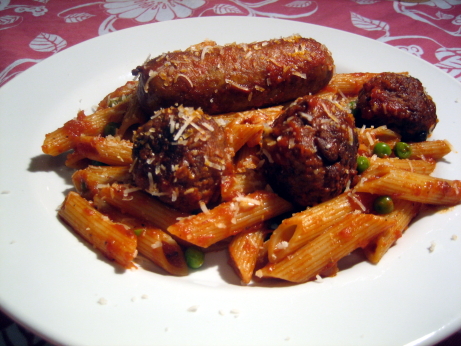
I can’t find the recipe for this one online, but you can easily fake it. Last time I gave you the recipe for the life changingly good meatballs used in this recipe and they’re by far the most important part.
I mentioned that I’d be putting those meatballs up against one of the boys’ version of a Sicilian meatball. In the end we did have a meatball battle, but I have no time for looking backwards, so I chose a recipe from the book I hadn’t made yet as my contender. I went with Meatballs in Tomato Sauce, which were very traditional, and basic. There was some mention in the comments that currants, pine nuts, and sweet spices might not be appealing meatball ingredients to everyone, and the battle proved this out. I quite liked his take on the Sicilian meatball, and it was my pick for the battle winner. I’m not sure who won, or who actually voted, or whether anyone was keeping track, but my simple meatballs gathered their share of votes. The reasons given were mostly that people didn’t like some flavour in the Sicilian meatballs though. To each their own.
In this recipe the Sicilian meatballs, and sweet Italian sausages are browned in a large pot. The meat is removed and onions are softened in the remaining oil, then garlic is added and cooked for a couple of minutes. Red wine, a bay leaf, tomato paste and purée are added to the pot, and the meat is nestled back in. The ragù is left to simmer for an hour and a half. Five minutes before serving, frozen green peas are stirred in. The meat is then removed, and some of the sauce is tossed with cooked perciatelli or ridged penne and served. The Book says that traditionally the pasta would be served as a first course, and the sausage and meatballs as a second, but in this recipe the meat is piled on the pasta and served.
I was quite pleased with the sauce, especially because it was infused with the flavours of the meatballs and sausages. The sauce was rich and wonderfully aromatic, and the red wine helped it surpass a standard spaghetti sauce. I like peas in pasta sauces, especially when the pasta’s shape lets them hide inside, and in such a deeply flavoured slow simmered dish their bright freshness was especially welcome. For all the goodness of the sauce, the highlight was really the meatballs, the sausages were entirely forgettable. I used bog standard grocery store Italian sausages, which are always fine, and sometimes pretty darn good, but maybe using a better quality product would have been worth it in this case. I wasn’t happy with the lewd appearance the sausages and meatballs gave the dish, and it’s hard to cut up a sausage when it’s sitting on a pile of pasta. If I used sausage again I’d definitely slice it ahead of time, and toss it with the pasta. I know I’ve said it enough at this point, but by far the best part of the recipe was the meatballs, and it was hard to care about any of the rest of it when they were on the plate.
I was altogether happy with this dish. I especially liked that the cinnamon from the meatballs perfused the tomato sauce. In Quebec cinnamon in spaghetti sauce is very very common, and I grew up on it. It doesn’t appear to be all that popular in the English speaking bits of North America, so I’m pleased to see that this winner of a flavour combination made it into The Book somewhere. Between making the meatballs and simmering the sauce this recipe takes forever, but it’s ideal for chilly days with pouring rain, or snowstorms. This ragù was wonderfuly warming and comforting, if I’d been out skiing all day this is exactly the dish I’d want waiting for me when I got home.